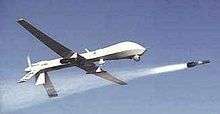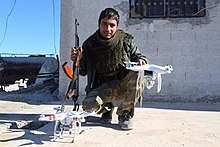Drone strike
A drone strike is an attack by one or more unmanned combat aerial vehicles (UCAV) or weaponized commercial unmanned aerial vehicles (UAV).


| Part of a series on |
| War |
|---|
|
|
|
Related
|
For unmanned combat aerial vehicles, an attack usually involves firing a missile or releasing a bomb at a target.[1] The drone may be equipped with such weapons as guided bombs, cluster bombs, incendiary devices, air-to-surface missiles, air-to-air missiles, anti-tank guided missiles or other types of precision-guided munitions, autocannons and machine guns.[2] Since the turn of the century, most drone strikes have been carried out by the US military in such countries as Afghanistan, Pakistan, Syria, Iraq, Somalia, and Yemen using air-to-surface missiles.[3]
Drones strikes are used for targeted killings by several countries.[4][5]
Only the United States, Israel, China, Iran, Italy, India, Pakistan, Russia, Turkey, and Poland[6][7] are known to have manufactured operational UCAV as of 2019.[8]
Drone attacks can be done by weaponized commercial unmanned aerial vehicles (UAVs), such as being loaded with dangerous payloads, and crashed into vulnerable targets or detonated above them. They can also drop hand grenades or other munitions. Payloads could include explosives, shrapnel, chemical, radiological or biological hazards. Multiple drones may attack simultaneously in a so-called "drone swarm attack".[9] Anti-UAV systems are being developed by states to counter the threat of drone strikes.[10] This is, however, proving difficult. According to James Rogers, an academic who studies drone warfare, "There is a big debate out there at the moment about what the best way is to counter these small UAVs, whether they are used by hobbyists causing a bit of a nuisance or in a more sinister manner by a terrorist actor."[11]
Drone strikes by the United States
In 1991, both AAI RQ-2 Pioneer and AeroVironment FQM-151 Pointer drones were used for surveillance during the Gulf War. In 1993, General Atomics GNAT UAVs were tested for surveillance in the Yugoslav Wars. In 2001–2002, General Atomics MQ-1 Predator drones were equipped with missiles to strike enemy targets.[12]
However, Ben Emmerson, special investigator for the United Nations Human Rights Council, said that U.S. drone strikes may have violated international humanitarian law.[13][14] The Intercept reported, "Between January 2012 and February 2013, U.S. special operations airstrikes [in northeastern Afghanistan] killed more than 200 people. Of those, only 35 were the intended targets. During one five-month period of the operation, according to the documents, nearly 90 percent of the people killed in airstrikes were not the intended targets."[15][16] In the United States drone strikes are used to lessen the number of casualties since there is no one that has to physically fight in combat. Being able to send drones to fight reduces the number of American lives lost substantially.[17] The U.S had increased the use of drone strikes significantly during Obama's presidency compared to Bush's.[18]With the help from joint defense facility at Pine Gap, which locates targets by intercepting radio signals, the U.S. is double-tap drone striking.[19][20][21]
In August 2018, Al Jazeera reported that a Saudi Arabian-led coalition "battling Houthi rebels [in Yemen] secured secret deals with al-Qaeda in Yemen and recruited hundreds of the group's fighters. ... Key figures in the deal-making said the United States was aware of the arrangements and held off on drone attacks against the armed group, which was created by Osama bin Laden in 1988."[22][23][24]
Drone strikes by the Islamic State
Small drones and quadcopters have been used for strikes by the Islamic State in Iraq and Syria. A group of twelve or more have been piloted by specially trained pilots to drop munitions onto enemy forces. They have been able to evade ground defense forces.[25]
During the battle for Mosul, the Islamic State was able to kill or wound dozens of Iraqi soldiers by dropping light explosives or 40-millimeter grenades from numerous drones attacking at the same time.
FBI Director Christopher Wray stated at a Senate hearing that "We do know that terrorist organizations have an interest in using drones ... We have seen that overseas already with some frequency. I think that the expectation is that it is coming here, imminently."[25]
Notable drone strikes
- Damadola airstrike
- Datta Khel airstrike
- 2009 Makin airstrike
- Miramshah airstrike
- Anad base drone strike
- 2019 Abqaiq-Khurais attack
- 2020 Baghdad International Airport airstrike
Strikes using small UAVs
- Swarm drone attacks on Khmeimim Air Base
- Caracas drone attack, allegedly by weaponized commercial drones, while Nicolás Maduro, the President of Venezuela, was addressing the Bolivarian National Guard.
Notable deaths from drone strikes
- Sally-Anne Jones
- Abdul Rauf (Taliban governor)
- Abdul Rauf Aliza
- Abdulrahman al-Awlaki
- Abu Khayr al-Masri
- Abu Muslim al-Turkmani
- Abu Umar al-Tunisi
- Ali Awni al-Harzi
- Anwar al-Awlaki
- Fahd al-Quso
- Harith bin Ghazi al-Nadhari
- Ibrahim Sulayman Muhammad Arbaysh
- Jihadi John
- Junaid Hussain
- Kamal Derwish
- Mangal Bagh
- Mohammed Atef
- Muhsin al-Fadhli
- Nasir al-Wuhayshi
- Nasser bin Ali al-Ansi
- Qaed Salim Sinan al-Harethi
- Qasem Soleimani
- Said Ali al-Shihri
- Saleh Ali al-Sammad
- Samir Khan
See also
- Anti-aircraft warfare § AUDS
- Public opinion about US drone attacks
- Civilian casualties from U.S. drone strikes
References
- Agence France-Presse (14 March 2017). "US military deploys attack drones to South Korea". Defence Talk. Retrieved 2 October 2017.
- "Turkey is getting military drones armed with machine guns | New Scientist".
- Haltiwanger, John (18 December 2018). "America at war: The countries where the US took or gave fire in 2018". Business Insider. Insider Inc. Retrieved 23 March 2019.
- "The global targeted killings bandwagon: who's next after France?". theconversation.com. 8 February 2017. Retrieved 23 March 2019.
- Byman, Daniel L. (17 June 2013). "Why Drones Work: The Case for Washington's Weapon of Choice". Brookings.edu. Retrieved 23 March 2019.
- Sabak, Juliusz (18 May 2017). "AS 2017: Warmate UAV with Ukrainian Warheads". Defence24.com. Retrieved 23 March 2019.
- Baykar Technologies (17 December 2015). 17 Aralık 2015—Tarihi Atış Testinden Kesitler (YouTube). Retrieved 18 November 2018.
- "Milli İHA'ya yerli füze takıldı!". Haber7. 18 December 2015. Retrieved 18 November 2018.
- "Syria war: Russia thwarts drone attack on Khmeimim airbase". BBC. 2018-01-07.
- "The dark side of our drone future". Bulletin of the Atomic Scientists. 2019-10-04. Retrieved 2020-04-19.
- Loeb, Josh (6 March 2017). "Anti-drone technology to be test flown on UK base amid terror fears". Engineering and Technology. The Institution of Engineering and Technology. Retrieved 9 May 2017.
- "From Desert Storm to Soleimani: how US drone warfare has evolved". Financial Times. 9 January 2020.
- Drone strikes by US may violate international law, says UN Archived 2013-10-18 at the Wayback Machine. The Guardian. 18 October 2013.
- UN report calls for independent investigations of drone attacks Archived 2018-03-24 at the Wayback Machine. The Guardian. 18 October 2013.
- "The Obama Administration's Drone-Strike Dissembling Archived 2018-03-25 at the Wayback Machine". The Atlantic. 14 March 2016.
- "The Assassination Complex Archived 2018-03-30 at the Wayback Machine". The Intercept. 15 October 2015.
- Lerner, Ben (Autumn 2015). "Drones and Targeted Killings: Ethics, Law, Politics". Parameters (Review): 118+. Retrieved 2018-05-03.
- Vogel, Ryan J. (Winter 2010). "Drone warfare and the law of armed conflict". Denver Journal of International Law and Policy: 101+. Retrieved 2018-05-08.
- Randle, Justin (2013-07-29). "Australia and drones: time for an honest and public debate | Justin Randle". The Guardian. ISSN 0261-3077. Retrieved 2019-08-18.
- Briefing, Peter Cronau for Background (2017-08-20). "Leaked documents reveal Pine Gap's role in the US fighting machine". ABC News. Retrieved 2019-08-18.
- "Australia's role in drone strikes—connecting the dots". Foreign Policy Blogs. 2018-01-10. Retrieved 2019-08-18.
- "Report: Saudi-UAE coalition 'cut deals' with al-Qaeda in Yemen". Al-Jazeera. 6 August 2018. Archived from the original on 2018-10-24. Retrieved 2018-11-18.
- "US allies, Al Qaeda battle rebels in Yemen". Fox News. 7 August 2018. Archived from the original on 2018-09-28. Retrieved 2018-11-18.
- "Allies cut deals with al Qaeda in Yemen to serve larger fight with Iran". San Francisco Chronicle. 6 August 2018. Archived from the original on 2018-08-15. Retrieved 2018-11-18.
- Hennigan, W.J. (28 September 2017). "Islamic State's deadly drone operation is faltering, but U.S. commanders see broader danger ahead". L.A. Times. Archived from the original on 2017-10-01. Retrieved 2 October 2017.
External links
